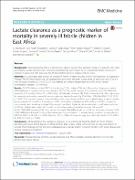Lactate clearance as a prognostic marker of mortality in severely ill febrile children in East Africa
Date
2018Author
Aramburo, A
Todd, Jim
George, Elizabeth C.
Kiguli, Sarah
Olupot-Olupot, Peter
Opoka, Robert O
Engoru, Charles
Akech, Samuel O
Nyeko, Richard
Mtove, George
Gibb, Diana M
Babiker, Abdel G
Maitland, Kathryn
Metadata
Show full item recordAbstract
Background: Hyperlactataemia (HL) is a biomarker of disease severity that predicts mortality in patients with sepsis
and malaria. Lactate clearance (LC) during resuscitation has been shown to be a prognostic factor of survival in
critically ill adults, but little data exist for African children living in malaria-endemic areas.
Methods: In a secondary data analysis of severely ill febrile children included in the Fluid Expansion as Supportive
Therapy (FEAST) resuscitation trial, we assessed the association between lactate levels at admission and LC at 8 h
with all-cause mortality at 72 h (d72). LC was defined as a relative lactate decline ≥ 40% and/or lactate
normalisation (lactate < 2.5 mmol/L).
Results: Of 3170 children in the FEAST trial, including 1719 children (57%) with Plasmodium falciparum malaria,
3008 (95%) had a baseline lactate measurement, 2127 (71%) had HL (lactate ≥ 2.5 mmol/L), and 1179 (39%) had
severe HL (≥ 5 mmol/L). Within 72 h, 309 children (10.3%) died, of whom 284 (92%) had baseline HL. After adjustment
for potential confounders, severe HL was strongly associated with mortality (Odds Ratio (OR) 6.96; 95% CI 3.52, 13.76,
p < 0.001). This association was not modified by malaria status, despite children with malaria having a higher baseline
lactate (median 4.6 mmol/L vs 3 mmol/L; p < 0.001) and a lower mortality rate (OR = 0.42; p < 0.001) compared to
non-malarial cases. Sensitivity and specificity analysis identified a higher lactate on admission cut-off value predictive
of d72 for children with malaria (5.2 mmol/L) than for those with other febrile illnesses (3.4 mmol/L).
At 8 h, 2748/3008 survivors (91%) had a lactate measured, 1906 (63%) of whom had HL on admission, of whom 1014
(53%) fulfilled pre-defined LC criteria. After adjustment for confounders, LC independently predicted survival after 8 h
(OR 0.24; 95% CI 0.14, 0.42; p < 0.001). Absence of LC (< 10%) at 8 h was strongly associated with death at 72 h (OR 4.
62; 95% CI 2.7, 8.0; p < 0.001).
Conclusions: Independently of the underlying diagnosis, HL is a strong risk factor for death at 72 h in children
admitted with severe febrile illnesses in Africa. Children able to clear lactate within 8 h had an improved chance of
survival. These findings prompt the more widespread use of lactate and LC to identify children with severe disease and
monitor response to treatment.
Collections
- Research Articles [24]

